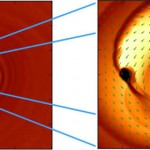 Simulation of the pair of supermassive black hole binary system, PG 1302-102. The smaller shines more brightly because it’s farther from the center of mass, and thus closer to the outer disk of gas. This gas accretes onto the black hole, heating up as it falls in, and thus emits more light. The more massive black hole, therefore, is starved of gas and doesn’t glow as brightly. (credit: Zoltan Haiman, Columbia University ) Data from NASA’s Galaxy Evolution Explorer ( GALEX ) and the Hubble Space Telescope has confirmed the presence of a pair of supermassive black holes orbiting each other so closely that they’re moving at relativistic speeds—a significant fraction of the speed of light. Supermassive black holes are expected to come in pairs pretty often. That’s because every galaxy has its own supermassive black hole, and galaxies often merge, bringing the two together. These mergers are very slow processes that distort both galaxies until their stars settle into new orbits (a process known as “violent relaxation”). While this is happening, extremely heavy objects, such as supermassive black holes, will tend to move in toward the center of the new galaxy. The new galaxy would end up with two supermassive black holes, one from each original galaxy, orbiting each other at its core. Objects have been observed which look a lot like supermassive black hole binaries, matching the prediction. These objects have a lot of mass—billions of times the mass of the Sun, as we’d expect from a pair of supermassives—and they’re periodic, meaning the amount of light the object produces rises and falls with a predictable time period. Read 17 remaining paragraphs | Comments
Simulation of the pair of supermassive black hole binary system, PG 1302-102. The smaller shines more brightly because it’s farther from the center of mass, and thus closer to the outer disk of gas. This gas accretes onto the black hole, heating up as it falls in, and thus emits more light. The more massive black hole, therefore, is starved of gas and doesn’t glow as brightly. (credit: Zoltan Haiman, Columbia University ) Data from NASA’s Galaxy Evolution Explorer ( GALEX ) and the Hubble Space Telescope has confirmed the presence of a pair of supermassive black holes orbiting each other so closely that they’re moving at relativistic speeds—a significant fraction of the speed of light. Supermassive black holes are expected to come in pairs pretty often. That’s because every galaxy has its own supermassive black hole, and galaxies often merge, bringing the two together. These mergers are very slow processes that distort both galaxies until their stars settle into new orbits (a process known as “violent relaxation”). While this is happening, extremely heavy objects, such as supermassive black holes, will tend to move in toward the center of the new galaxy. The new galaxy would end up with two supermassive black holes, one from each original galaxy, orbiting each other at its core. Objects have been observed which look a lot like supermassive black hole binaries, matching the prediction. These objects have a lot of mass—billions of times the mass of the Sun, as we’d expect from a pair of supermassives—and they’re periodic, meaning the amount of light the object produces rises and falls with a predictable time period. Read 17 remaining paragraphs | Comments
Continue reading here:
Supermassive black holes found spiraling in at seven percent light speed





